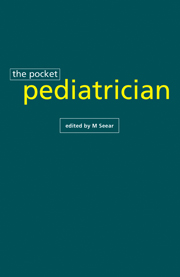Book contents
- Frontmatter
- Contents
- Analytical contents list
- Preface
- 1 Cardiology
- 2 Death and dying
- 3 Emergencies
- 4 Endocrinology
- 5 Fluids and electrolytes
- 6 Gastroenterology
- 7 General surgery
- 8 Health care ethics
- 9 Hematology
- 10 Infectious diseases
- 11 Intensive care and continuous infusion drugs
- 12 Medical genetics
- 13 Neonatology and neonatal drug dosage guidelines
- 14 Neurology
- 15 Nutrition
- 16 Oncology
- 17 Pediatric transport
- 18 Pharmacology and drug dosage guidelines
- 19 Renal
- 20 Resident fellow training
- 21 Respirology
- 22 Rheumatology
- 23 Transfusion medicine
- 24 Appendix
- Index
1 - Cardiology
Published online by Cambridge University Press: 01 February 2010
- Frontmatter
- Contents
- Analytical contents list
- Preface
- 1 Cardiology
- 2 Death and dying
- 3 Emergencies
- 4 Endocrinology
- 5 Fluids and electrolytes
- 6 Gastroenterology
- 7 General surgery
- 8 Health care ethics
- 9 Hematology
- 10 Infectious diseases
- 11 Intensive care and continuous infusion drugs
- 12 Medical genetics
- 13 Neonatology and neonatal drug dosage guidelines
- 14 Neurology
- 15 Nutrition
- 16 Oncology
- 17 Pediatric transport
- 18 Pharmacology and drug dosage guidelines
- 19 Renal
- 20 Resident fellow training
- 21 Respirology
- 22 Rheumatology
- 23 Transfusion medicine
- 24 Appendix
- Index
Summary
HEART DISEASE IN INFANCY
Congenital heart disease represents the commonest major structural malformation. It occurs in roughly 12:1,000 live born infants. Under normal circumstances, 8:1,000 will be recognized during the first year of life; two of these will present with critical heart disease requiring some form of intervention in the first few months of life. The presentation of heart disease usually comes in one of three forms: congestive heart failure, cyanosis and/or cardiac murmur.
Although expensive studies such as angiography and gated MRI's have a part to play in the investigation of children with heart disease, it is possible to make a diagnosis using little more than clinical skills, an electrocardiogram (ECG) and a chest radiograph.
Heart failure
The classical signs of heart failure are cardiomegaly, tachypnea and hepatomegaly. Left–sided failure causes pulmonary vascular congestion, interstitial edema and decreased compliance. The child's response is to develop rapid shallow breathing. Early heart failure can easily be confused with respiratory disease. Lymphatic obstruction can cause small airway obstruction with hyperinflation and wheeze (so called “cardiac asthma”). Pulmonary crackles are a late sign and are rarely heard. Right–sided failure causes systemic venous congestion, which is generally accommodated by a distended liver. Peripheral edema is a very late sign of right–sided failure. In practice, either pure right or left–sided failure is uncommon since the distended failing ventricle rapidly impedes the function of the other ventricle.
Presentation
The presenting features may develop slowly and mimic other diseases, especially respiratory disease. Some of the major presenting signs and symptoms are:
Respiratory: wheeze, tachypnea, cough, retractions.
Cardiac: hypotension, poor pulses, tachycardia, gallop, cardiomegaly.
Peripheral perfusion: pale, mottled, cyanosed, cool peripheries.
- Type
- Chapter
- Information
- The Pocket PediatricianThe BC Children's Hospital Manual, pp. 1 - 12Publisher: Cambridge University PressPrint publication year: 1996

